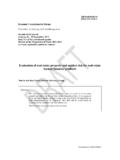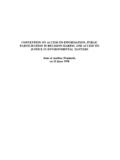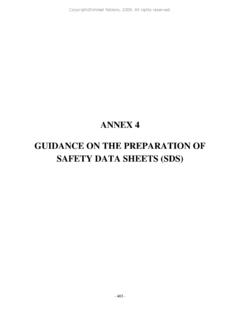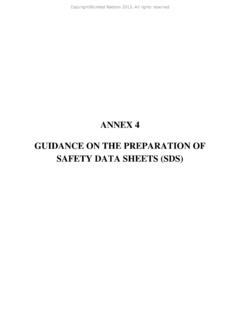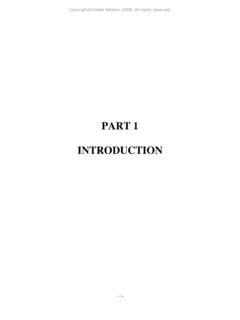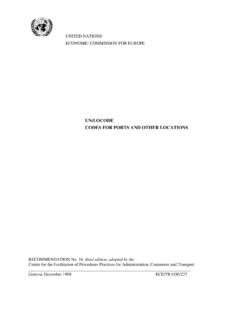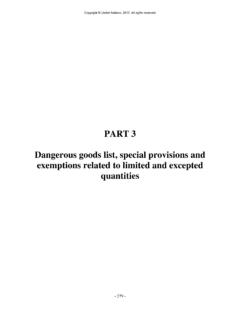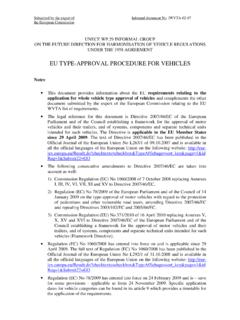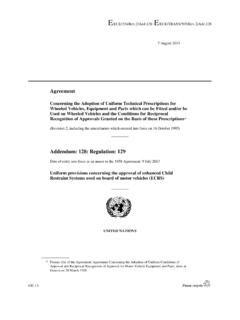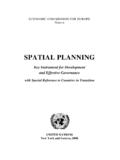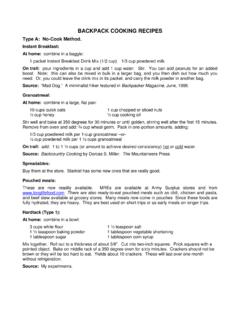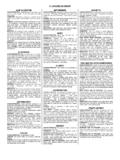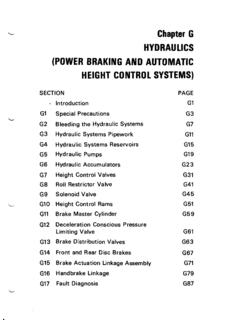Transcription of What is Boil-off - UNECE Homepage
1 1 The global leader in natural gas is Boil-off ?Prepared for: LNG Task Force meeting in Brussels, November 3, 2011 Prepared by: Mihai Ursan, PhD., Present and define Boil-off as it is in the cryogenic industry and detail the specifics of it when applied to vehicle LNG tanks. Provide basic knowledge on the Boil-off and quantify venting required to avoid a dangerous situation. 3/11 Summary Boil-off in the cryogenic industryyWhat is Boil-off ?yMeasures for Boil-off ? LNG vehicle tanksyBoil-off for the vehicle LNG TankyHeat management and types of fuel delivery systemsyWhat if, tank pressure rise above the maximum operating limit? Conclusions4/11 what is Boil-off ? A cryogenic fluid is typically kept at low temperatures in a storage vessel.
2 The storage has a major challenge due to the inherent heat input from the environment. The effect of the heat input is warming of the cryogenic fluid:yIf (constant volume) Pressure increase in the storage vessel yIf (constant pressure) Fluid boils and Boil-off vapours are released from the vessel (venting) The vapours created due to the ambient heat input (while maintaining constant pressure in the storage vessel) are called Boil-off . yThe discharge of these vapours out of the storage container is called for Boil-off Storage vessels for cryogenic liquidsyThe Boil-off is inherent to the storage of a cryogenic due to the heat input from cryogenic vessels are designed to fit the application needs. yFor example: For a laboratory vessel holding liquid nitrogen, the Boil-off is a simple line that vents the vapours to atmosphere (N2 is not a pollutant).
3 For a natural gas, peak-shaving plant the Boil-off system collects the NG vapours, heats them close to ambient temperature, odorizes the gas, compresses it and re-injects into the gas distribution system. Measures for boil -offyThe measure for the Boil-off is the amount of vapours per unit time Boil-off rate. yIt can be an absolute measure kg/h, kg/day or a relative measure % vaporized from total amount per unit the previous example: For a laboratory vessel holding liquid nitrogen, the Boil-off rate may be kg/h. For the natural gas peak-shaving plant storage tank the Boil-off rate may be Boil-off rate can be used determine how long you can hold the cryogenic fluid in the specific container. For the laboratory vessel, the cryogen will be vented in 50 hours (assume vessel capacity is 5 kg of liquid) and for the peak-shaving plant storage the whole content will be processed in 2000 days = vehicle tanks Boil-off for the vehicle LNG TankyLNG is a cryogenic liquid stored in a tank on-board the vehicle.
4 Inherently heat from ambient flows in and warms the this application, the tanks are designed to take higher pressure, therefore being able to contain the LNG without release of vapour. yThe time the tank can hold the LNG without venting is called holding time . By codes in US and Canada the holding time is 5 management and types of fuel delivery systems Dealing with the amount of heat accumulated in the tank depends on the fuelling station and vehicle application. Among other references available in the industry [3] has a good presentation of fuel delivery systems. The paper considers two types of delivery systems: vapour collapse system and vapour return system 8/11 The delivery pressure is below the tank maximum working pressure.
5 The vehicle tank is equipped with an economizer that is capable to draw vapours from tank. It maintains the tank pressure constant. At the fuelling station, cold LNG is sprayed on top of the tank and the temperature of the residue vapour in the tank is lowered until vapour condenses (collapse). This reduces the pressure in the tank allowing it to be refuelled. The delivery pressure is above the tank maximum working pressure. The fuel system has a pump that draws liquid and pressurise it. The pressure in the tank may decrease, maintain steady or increase depending on the rate the fuel is drawn out of the cases are of pressure increase in the LNG tank At the fuelling station cold LNG is sprayed on top of the tank and depending on the initial condition of the tank, vapours in the tank may or may not collapse.
6 When there is a pressure increase, vapours are transferred to the fuelling station. This reduces the pressure in the tank allowing it to be refuelled. Vapour transfer to fuelling station or on-board processing of vapours reduces the tank pressure and resets the clock on holding time. Best practice and experience is the key to successful if, tank pressure rise above the maximum operating limit? If, due to any unforeseen situations the pressure in the tank rises above the maximum operating limit, this is considered a dangerous situation. To avoid the danger the tank has a pressure relief valve that will allow venting to atmosphere. To quantify the release of gas for such a safety event will do the following assumptions:yConsider pure methane properties in lieu of LNG propertiesyThe tank contains 400 liter (106 gallon) of liquidyThe pressure relief valve opens at bar (230 psi) and re-sets at bar (210 psi).
7 YThe amount of vapours and their influence is neglectedyThe sensible heat of the inner vessel is neglected Amount of liquid:ym = V * = 400/1000 * = kg Specific enthalpy difference (specific heat to remove from the tank to cool-down the liquid):yh = h( ) h( ) = = kJ/kg Enthalpy difference (the amount of heat to remove from the tank to cool-down the liquid):yH = h * m = * = kJ The heat of vaporisation (average difference between the enthalpy of vapours and liquid at the considered pressures):yh(vaporisation) = 1/2 * [ (h(V, ) h(L, )) + (h(V, ) h(L, )) ]y= * [( ) + ( )] = kJ/kg Amount of vapours evaporated to remove the heat:ym(vapours) = H / h(vaporisation) = / = kg Relative to the initial amount of liquid in the tank:yr = m(vapours) / m = / = = % The amount of vapours vented to lower the tank pressure from bar (230 psi) to bar (210 psi) is kg per event.
8 This represents (by mass) of the initial amount of liquid in the The use of LNG has the inherent time factor, due to the heat input from the ambient to the vehicle tank. As required by codes in US and Canada, the LNG vehicle tanks are designed to contain the LNG for 5 days without venting. For normal operation, there is no release of natural gas to atmosphere. Vapour transfer to fuelling station or on-board processing of vapours reduces the tank pressure and resets the clock on holding time. Best practice and experience is the key to successful operation. To avoid a dangerous condition, due to pressure increase above the maximum operating limit, the LNG tank will vent to atmosphere a limited amount of and Contact info References:y1 Barron, Randal F, Cryogenic Systems, Second Edition, Oxford University Press, 1985 y2 Weisend II, J.
9 G., Handbook of Cryogenic Engineering, Taylor and Francis, 1998 y3 Wegrzyn, J., Gurevich, M., Liquefied Natural Gas for Trucks and Buses , SAE Paper No. 2000-01-2210 Contact infoyWestport Power Ursan, PhD.
